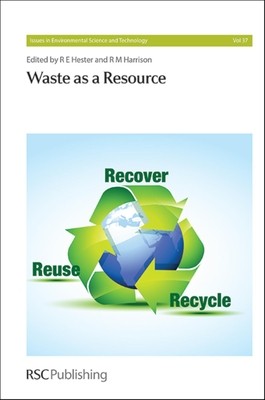
- We will send in 10–14 business days.
- Publisher: Royal Society of Chemistry
- Year: 2013
- Pages: 252
- ISBN-10: 1849736685
- ISBN-13: 9781849736688
- Format: 16.3 x 24.1 x 2.1 cm, hardcover
- Language: English
- SAVE -10% with code: EXTRA
Waste as a Resource (e-book) (used book) | bookbook.eu
Reviews
Description
The volume of waste produced by human activity continues to grow, but steps are being taken to mitigate this problem by viewing waste as a resource. Recovering a proportion of waste for re-use immediately reduces the volume of landfill. Furthermore, the scarcity of some elements (such as phosphorous and the rare-earth metals) increases the need for their recovery from waste streams.
This volume of Issues in Environmental Science and Technology examines the potential resource available from several waste streams, both domestic and industrial. Opportunities for exploiting waste are discussed, along with their environmental and economic considerations. Landfill remains an unavoidable solution in some circumstances, and the current situation regarding this is also presented. Other chapters focus on mine waste, the recovery of fertilisers, and the growing potential for compost.
In keeping with the Issues series, this volume is written with a broad audience in mind. University students and active researches in the field will appreciate the latest research and discussion, while policy makers and members of NGOs will benefit from the wealth of information presented.
EXTRA 10 % discount with code: EXTRA
The promotion ends in 20d.20:20:16
The discount code is valid when purchasing from 10 €. Discounts do not stack.
- Publisher: Royal Society of Chemistry
- Year: 2013
- Pages: 252
- ISBN-10: 1849736685
- ISBN-13: 9781849736688
- Format: 16.3 x 24.1 x 2.1 cm, hardcover
- Language: English English
The volume of waste produced by human activity continues to grow, but steps are being taken to mitigate this problem by viewing waste as a resource. Recovering a proportion of waste for re-use immediately reduces the volume of landfill. Furthermore, the scarcity of some elements (such as phosphorous and the rare-earth metals) increases the need for their recovery from waste streams.
This volume of Issues in Environmental Science and Technology examines the potential resource available from several waste streams, both domestic and industrial. Opportunities for exploiting waste are discussed, along with their environmental and economic considerations. Landfill remains an unavoidable solution in some circumstances, and the current situation regarding this is also presented. Other chapters focus on mine waste, the recovery of fertilisers, and the growing potential for compost.
In keeping with the Issues series, this volume is written with a broad audience in mind. University students and active researches in the field will appreciate the latest research and discussion, while policy makers and members of NGOs will benefit from the wealth of information presented.


Reviews